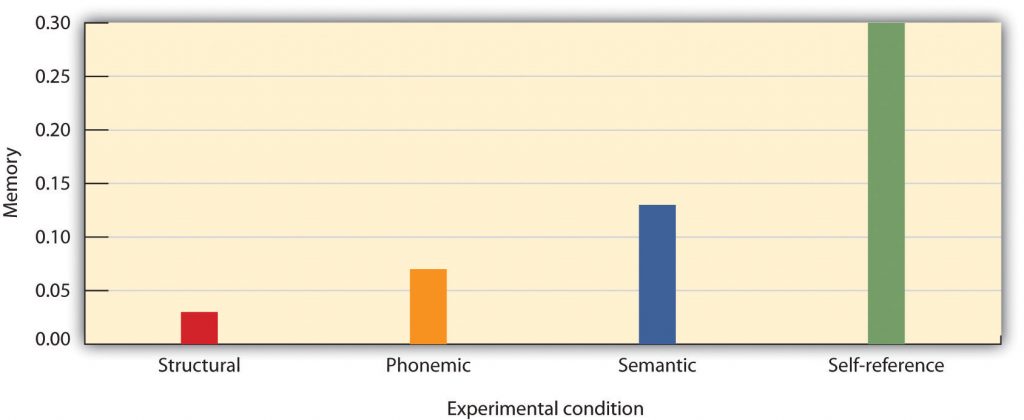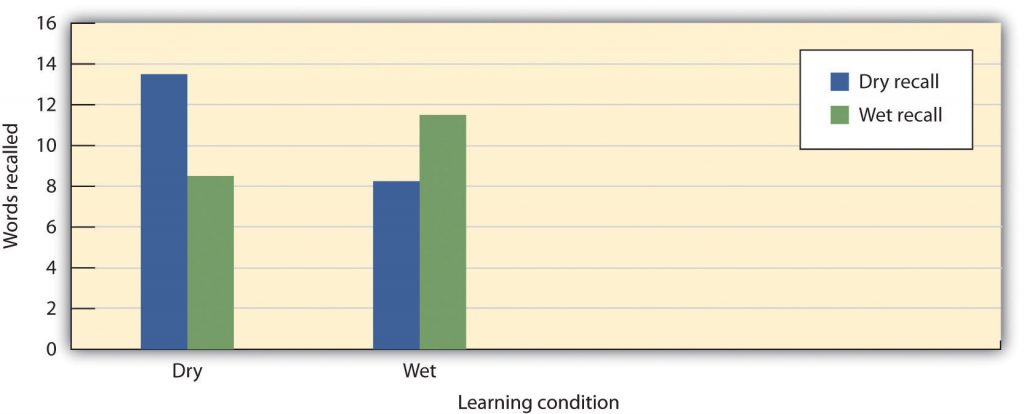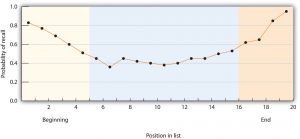10.3 Long-Term Memory: Encoding and Storage
Learning Objectives
- Label and review the principles of encoding, storage, and retrieval.
- Describe how the context in which we learn information can influence our memory of that information.
Encoding and storage: How our perceptions become memories
To be available in long-term memory, the information that we want to remember must be encoded, stored, and then retrieved. In this section, we will consider the types of processing we do of the information we want to remember.
Encoding is the process by which we place the things that we experience into memory. Unless information is encoded, it cannot be remembered. I’m sure you’ve been to a party where you’ve been introduced to someone, and then — maybe only seconds later — you realize that you do not remember the person’s name. Of course, it’s not really surprising that you can’t remember the name, because you probably were distracted and never encoded the name to begin with.
Not everything we experience can or should be encoded. We tend to encode things that we need to remember and not bother to encode things that are irrelevant. If you attempted to encode everything, your thoughts would quickly become cluttered and overwhelming. Imagine yourself walking out of your house and down the street, encoding the number of trees you see, the license plate number of every car, the colour of the hair of all the pedestrians, and so on. Not encoding everything is a survival strategy.
However, sometimes we don’t encode information into long term memory when we should or when we need to. Understanding what should be encoded, and what should not, is a complex task sometimes, especially for students. They may feel overwhelmed by the sheer volume of information presented in a textbook or lecture and be unable to identify what is critical for encoding.
One way to improve our memory is to use better encoding strategies. Some ways of studying are more effective than others. Research has found that we are better able to remember information if we encode it in a meaningful way. When we engage in elaborative encoding, we process new information in ways that make it more relevant or meaningful (Craik & Lockhart, 1972; Harris & Qualls, 2000). Each person has their unique way of elaborating on information; the important thing is to try to develop unique and meaningful associations among the materials.
Elaborative encoding of the contents of this chapter, for example, would be to find personal examples of the concepts — those concepts in bold font would be a good place to start. You could draw a picture in your notes to describe what is going on. You might explain one of the concepts to a friend or relative. You could create a mind map of the key points, with the map becoming bigger as you add more concepts. You could employ mnemonics like ROYGBIV, which is an anagram containing the letter of the first word of all colours in the visual spectrum, or OCEAN, which is another anagram of first letters, but this time for the five personality factors in the “Big Five” model. For more examples, see Lou Whitaker’s article “What Are Some Elaborative Rehearsal Strategies That Will Transfer Learning Into Long-Term Memory?” (n.d.). Students often rely on reading or highlighting the textbook to encode material into long term memory; however, this is a relatively poor strategy because it is passive, and it can “feel” like you have accomplished something when, really, the material has not been meaningfully encoded. In addition, students often fail to “over-learn,” stopping their studying as soon as they can remember something once, instead of continuing to rehearse and encode material (Driskell, Willis, & Copper, 1992). Of course, using these elaborative encoding strategies requires good time management.
Research Focus
Elaboration and memory
In an important study showing the effectiveness of elaborative encoding, Timothy Rogers, Nicholas Kuiper, and William Kirker (1977) studied how people recalled information that they had learned under different processing conditions. All the participants were presented with the same list of 40 adjectives to learn, but through the use of random assignment, the participants were given one of four different sets of instructions about how to process the adjectives:
- In the structural task condition, participants judged whether the adjective was in uppercase or lowercase letters.
- In the phonemic task condition, participants were asked whether or not the adjective rhymed with a word they provided.
- In the semantic task condition, participants were asked if the adjective was a synonym of another word.
- In the self-reference task condition, participants indicated whether or not the adjective was true of themselves.
After completing the specified task, each participant was asked to remember as many adjectives as they could.
Rogers, Kuiper, and Kirker (1977) hypothesized that different types of processing would have different effects on memory. The students in the self-reference task condition recalled significantly more adjectives than did students in any other condition (see Figure 10.8). This finding, known as the self-reference effect, is powerful evidence that the self-concept helps us organize and remember information. The next time you are studying for an exam, you might try relating the material to your own experiences. The self-reference effect suggests that doing so will help you better remember the information (Symons & Johnson, 1997).

The contributions of Hermann Ebbinghaus
Hermann Ebbinghaus (1850–1909) was a pioneer of the study of memory. In this section, we consider one of his most important findings: the spacing effect. The spacing effect refers to the fact that learning is better if it is spread out over periods of time than if it occurs closer together or at the same time. This means that you will learn more if you study continually throughout the semester — a little bit every day is best — than if you wait to cram at the last minute before your exam (see Figure 10.9). Another good strategy is to study and wait as long as you can before you forget the material. Then, review the information and again wait as long as you can before you forget it. This will probably be a longer period of time than the first time. Repeat, and repeat again. The spacing effect is usually considered in terms of the difference between distributed practice (i.e., practice that is spread out over time) and massed practice (i.e., practice that comes in one block), with the former approach producing better memory.

Retrieval
Even when information has been adequately encoded and stored, it does not do us any good if we cannot retrieve it. Retrieval refers to the process of reactivating information that has been stored in memory. You can get an idea of the difficulty posed by retrieval by simply reading each of the words, but not the categories, in the table below to someone. Tell the person that after you have read all the words, you will ask them to recall the words.
After you read the list to your friend, give them enough time to write down all the words that they can recall. Make sure that they cannot recall any more. Then, for the words that were not listed, prompt your friend with some of the category names: “Do you remember any words that were furniture? Do you remember any words that were tools?” You may find that the category names, which serve as retrieval cues, will help your friend remember information that they could not retrieve otherwise.
Try this test of the ability to retrieve information with a friend using the instructions above and the table below.
| Word | Category |
| Apple | (Fruit) |
| Dresser | (Furniture) |
| Sander | (Tool) |
| Pomegranate | (Fruit) |
| Sunflower | (Flower) |
| Tangerine | (Fruit) |
| Chair | (Furniture) |
| Peony | (Flower) |
| Banana | (Fruit) |
| Sofa | (Furniture) |
| Bench | (Furniture) |
| Strawberry | (Fruit) |
| Television stand | (Furniture) |
| Magnolia | (Flower) |
| Rose | (Flower) |
| Wrench | (Tool) |
| Screwdriver | (Tool) |
| Dahlia | (Flower) |
| Drill press | (Tool) |
| Hammer | (Tool) |
We have all experienced retrieval failure in the form of the frustrating tip-of-the-tongue phenomenon, in which we are certain that we know something that we are trying to recall but cannot quite come up with it. Forgotten words are particularly prone to the tip-of-the-tongue phenomenon. We might think of words that are similar in sound, have the same number of syllables, or mean the same thing — but we cannot bring the actual word to mind. The tip-of-the-tongue experience is a very good example of the inability to retrieve information that is actually stored in memory. Eventually, the lost word will surface, though it might take a while.
We are more likely to be able to retrieve items from memory when conditions at retrieval are similar to the conditions under which we encoded them. Context-dependent learning refers to an increase in retrieval when the external situation in which information is learned matches the situation in which it is remembered. Duncan Godden and Alan Baddeley (1975) conducted a study to test this idea using scuba divers. They asked the divers to learn a list of words either when they were on land or when they were underwater. Then, they tested the divers on their memory, either in the same or the opposite situation. The divers’ memory was better when they were tested in the same context in which they had learned the words than when they were tested in the other context (see Figure 10.10).

You can see that context-dependent learning might also be important in improving your memory. For instance, you might want to try to study for an exam in a situation that is similar to the one in which you are going to take the exam.
Whereas context-dependent learning refers to a match in the external situation between learning and remembering, state-dependent learning refers to superior retrieval of memories when the individual is in the same physiological or psychological state as during encoding. Research has found, for instance, that animals that learn a maze while under the influence of one drug tend to remember their learning better when they are tested under the influence of the same drug than when they are tested without the drug (Jackson, Koek, & Colpaert, 1992). Additionally, research with humans finds that bilinguals remember better when tested in the same language in which they learned the material (Marian & Kaushanskaya, 2007). Mood states may also produce state-dependent learning. People who learn information when they are in a bad, rather than a good, mood find it easier to recall these memories when they are tested while they are in a bad mood, and vice versa. It is easier to recall unpleasant memories than pleasant ones when we’re sad, and easier to recall pleasant memories than unpleasant ones when we’re happy (Bower, 1981; Eich, 2008).
Variations in the ability to retrieve information are also seen in the serial position curve. When we give people a list of words one at a time (e.g., on flashcards) and then ask them to recall them, the results look something like those in Figure 10.11. People are able to retrieve more words that were presented to them at the beginning and the end of the list than they are words that were presented in the middle of the list. This pattern, known as the serial position curve, is caused by two retrieval phenomenon: The primacy effect refers to a tendency to better remember stimuli that are presented early in a list. The recency effect refers to the tendency to better remember stimuli that are presented later in a list.

There are a number of explanations for primacy and recency effects, but one of them is in terms of the effects of rehearsal on short-term and long-term memory (Baddeley, Eysenck, & Anderson, 2009). Because we can keep the last words that we learned in the presented list in short-term memory by rehearsing them before the memory test begins, they are relatively easily remembered. So, the recency effect can be explained in terms of maintenance rehearsal in short-term memory. As well, the primacy effect may also be due to rehearsal — when we hear the first word in the list we start to rehearse it, making it more likely that it will be moved from short-term to long-term memory. The same is true for the other words that come early in the list, but for the words in the middle of the list, this rehearsal becomes much harder, making them less likely to be moved to LTM.
Tips for storing in long term memory
As a student, you are intimately familiar with the challenges of remembering over the long term. We want to remember the name of our classmates, the title of the movie we saw last week, and the material for our upcoming psychology test. As you can see in the table below, psychological research has produced a great deal of knowledge about long-term memory, and this research can be useful as you try to learn and remember new material.
| Technique | Description | Useful Example |
|---|---|---|
| Use elaborative encoding. | Material is better remembered if it is processed more fully. | Draw diagrams, quiz yourself, explain the concept to someone else, use mnemonics, make mind maps. |
| Make use of the self-reference effect. | Material is better remembered if it is linked to thoughts about the self. | Write out or tell someone a personal example related to the concept you are trying to remember. |
| Be aware of the forgetting curve. | Information that we have learned drops off rapidly with time. | Review the material that you have already studied right before the exam to increase the likelihood it will remain in memory. |
| Make use of the spacing effect. | Information is learned better when it is studied in shorter periods spaced over time. | Study a little bit every day; do not cram at the last minute. |
| Rely on overlearning. | We can continue to learn even after we think we know the information perfectly. | Keep studying, even if you think you already have it down. Put your notes onto flashcards, and look at them many times. |
| Use context-dependent retrieval. | We have better retrieval when it occurs in the same situation in which we learned the material. | If possible, study under conditions similar to the conditions in which you will take the exam. |
| Use state-dependent retrieval. | We have better retrieval when we are in the same psychological state as we were when we learned the material. | Many possibilities with this, but don’t study under the influence of drugs or alcohol, unless you plan to use them on the day of the exam, which is not recommended. |
Key Takeaways
- Information that becomes part of our long-term memory must be encoded, stored, and then retrieved.
- Hermann Ebbinghaus made important contributions to the study of learning, including the spacing effect.
- Context- and state-dependent learning, as well as primacy and recency effects, influence long-term memory.
- Research on memory has useful suggestions for increasing yours.
Image Attributions
Figure 10.8. Used under a CC BY-NC-SA 4.0 license.
Figure 10.9. Used under a CC BY-NC-SA 4.0 license.
Figure 10.10. Used under a CC BY-NC-SA 4.0 license.
Figure 10.11. Used under a CC BY-NC-SA 4.0 license.
Long Description
Figure 10.8. Self-reference effect results:
| Experimental Condition | ||||
| Structural | Phonemic | Semantic | Self-Reference | |
| Memory | 0.03 | 0.07 | 0.13 | 0.30 |
Figure 10.10. Context-dependent learning:
| Number of words recalled on land | Number of words recalled in water |
|
| Words learned on land | 13 | 8.6 |
| Words learned in water | 8 | 10.4 |
References
Baddeley, A., Eysenck, M. W., & Anderson, M. C. (2009). Memory. New York, NY: Psychology Press.
Bower, G. H. (1981). Mood and memory. American Psychologist, 36, 129–148.
Craik, F. I., & Lockhart, R. S. (1972). Levels of processing: A framework for memory research. Journal of Verbal Learning & Verbal Behavior, 11(6), 671–684.
Driskell, J. E., Willis, R. P., & Copper, C. (1992). Effect of overlearning on retention. Journal of Applied Psychology, 77(5), 615–622.
Eich, E. (2008). Mood and memory at 26: Revisiting the idea of mood mediation in drug-dependent and place-dependent memory. In M. A. Gluck, J. R. Anderson, & S. M. Kosslyn (Eds.), Memory and mind: A festschrift for Gordon H. Bower (pp. 247–260). Mahwah, NJ: Lawrence Erlbaum.
Godden, D. R., & Baddeley, A. D. (1975). Context-dependent memory in two natural environments: On land and underwater. British Journal of Psychology, 66(3), 325–331.
Harris, J. L., & Qualls, C. D. (2000). The association of elaborative or maintenance rehearsal with age, reading comprehension and verbal working memory performance. Aphasiology, 14(5–6), 515–526.
Jackson, A., Koek, W., & Colpaert, F. (1992). NMDA antagonists make learning and recall state-dependent. Behavioural Pharmacology, 3(4), 415–421.
Marian, V. & Kaushanskaya, M. (2007). Language context guides memory content. Psychonomic Bulletin and Review, 14(5), 925–933.
Rogers, T. B., Kuiper, N. A., & Kirker, W. S. (1977). Self-reference and the encoding of personal information. Journal of Personality & Social Psychology, 35(9), 677–688.
Symons, C. S., & Johnson, B. T. (1997). The self-reference effect in memory: A meta-analysis. Psychological Bulletin, 121(3), 371–394.
Whitaker, L. (n.d.). What are some elaborative rehearsal strategies that will transfer learning into long-term memory? MeTEOR Education. Retrieved from https://meteoreducation.com/long-term-memory-2

